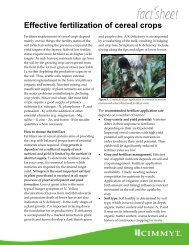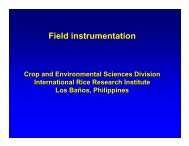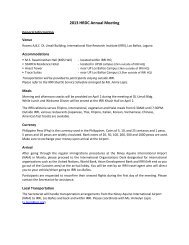choosing the right maize variety.pdf - Rice Knowledge Bank
choosing the right maize variety.pdf - Rice Knowledge Bank
choosing the right maize variety.pdf - Rice Knowledge Bank
You also want an ePaper? Increase the reach of your titles
YUMPU automatically turns print PDFs into web optimized ePapers that Google loves.
Choosing <strong>the</strong> <strong>right</strong> <strong>maize</strong> <strong>variety</strong><br />
With thousands of different varieties of crops<br />
available for farmers to choose from, it is<br />
important for farmers to select varieties most<br />
suitable for <strong>the</strong>ir conditions. Although many<br />
institutions are involved in promoting<br />
appropriate crop varieties to farmers, some<br />
recommendations do not take into account <strong>the</strong><br />
wide range of factors that influence <strong>the</strong> farmers’<br />
decision‐making. This has partly contributed to<br />
limited adoption of new crop varieties by<br />
smallholder farmers.<br />
• General loss of confidence in improved<br />
varieties and in <strong>the</strong> source of <strong>the</strong> seed (i.e.<br />
seed companies).<br />
• Rates of future adoption being affected.<br />
What <strong>the</strong> farmers want:<br />
• A <strong>variety</strong> that can improve <strong>the</strong>ir livelihoods,<br />
providing both food and income.<br />
• A <strong>variety</strong> that performs well each season,<br />
providing yield stability. Drought or any<br />
o<strong>the</strong>r environmental conditions should not<br />
endanger food/income security.<br />
• A <strong>variety</strong> that is not too expensive to grow.<br />
This cost perception will depend on farmer<br />
preferences. For instance, if farmers can<br />
recycle seed by using open pollinated <strong>maize</strong><br />
varieties (OPVs) instead of hybrid <strong>maize</strong><br />
varieties, <strong>the</strong>y could save money for<br />
acquiring o<strong>the</strong>r inputs (such as fertilizer).<br />
• Seed that is easily accessible on <strong>the</strong> market,<br />
affordable to purchase, and from a trusted<br />
source.<br />
Why is it important to get it <strong>right</strong><br />
Choosing <strong>the</strong> wrong or inappropriate <strong>variety</strong><br />
can result in:<br />
• Loss of yield, resulting in food insecurity<br />
and loss of profits. (For example, some<br />
imported varieties may never mature or<br />
may yield much lower than expected<br />
because <strong>the</strong>y are not adapted to<br />
environmental conditions in a particular<br />
area. This problem often occurs when when<br />
farmers use <strong>the</strong> grain from relief efforts or<br />
food help for sowing.)<br />
Figure 1. Seed may fail to emerge (foreground) even<br />
when <strong>the</strong> inappropriate <strong>variety</strong> is used.<br />
To select <strong>the</strong> <strong>right</strong> <strong>variety</strong>, it is important to<br />
know <strong>the</strong> general characteristics of your area in<br />
terms of:<br />
• Length of <strong>the</strong> growing season (depends on<br />
water availability/rainy season and<br />
optimum temperatures). This determines <strong>the</strong><br />
ideal maturity group.<br />
• Yield potential of <strong>the</strong> area. This is related to<br />
<strong>the</strong> environment (agroecological zone):<br />
rainfall and temperature patterns, soil<br />
characteristics, elevation, etc. Some varieties<br />
are more suitable for low and some for high<br />
yield potential areas.<br />
• Prevalent diseases and pests in <strong>the</strong> area.<br />
Look for varieties with resistance or<br />
tolerance to prevalent diseases and pests.<br />
• Crop choice of neighboring farms. Learn<br />
from successes and failures of neighboring<br />
farmers.<br />
Availability of such information helps to<br />
determine what characteristics a <strong>variety</strong> needs to<br />
perform well. These may include, for example,<br />
<strong>the</strong> degree of disease resistance, <strong>the</strong> maturity
group or whe<strong>the</strong>r drought or soil acidity<br />
tolerance is required.<br />
General maturity groups of <strong>maize</strong> varieties<br />
An early‐maturing <strong>variety</strong> can ei<strong>the</strong>r be planted<br />
early and be harvested before <strong>the</strong> end of <strong>the</strong><br />
season, late and be harvested by season‐end, or<br />
in areas where <strong>the</strong> rainy season is short.<br />
It is understandable that farmers see new<br />
varieties as risky; <strong>the</strong>ir survival is depending on<br />
<strong>the</strong> success of <strong>the</strong>ir crops. New varieties may be<br />
tested on small areas before being adopted for<br />
<strong>the</strong> entire farm.<br />
An intermediate‐maturing <strong>variety</strong> does not<br />
require a full season to mature, and tends to<br />
produce higher yields than early‐maturing<br />
varieties. It can be planted in areas where <strong>the</strong><br />
rains may stop early or harvested before <strong>the</strong> end<br />
of <strong>the</strong> season.<br />
A late‐maturing <strong>variety</strong> needs to be planted<br />
very early in <strong>the</strong> season, often with <strong>the</strong> first<br />
rains. Under favorable conditions, it gives <strong>the</strong><br />
highest yields.<br />
It is also crucial to keep in mind grain<br />
consumers’ criteria, considering:<br />
• Targeted use of <strong>the</strong> final product. Different<br />
varieties are often preferred when <strong>the</strong> grain<br />
is for home‐processing and storage<br />
compared to when it is intended for sale,<br />
processing, feed/silage, or for o<strong>the</strong>r special<br />
purposes.<br />
• Current market conditions – which <strong>variety</strong><br />
suits market requirements<br />
• Quality attributes in terms of <strong>the</strong> endproduct.<br />
In <strong>maize</strong>, intrinsic characteristics<br />
such as starch, oil, and protein content are<br />
closely related to <strong>the</strong> end‐use value. A<br />
<strong>variety</strong> that produces sweet and large cobs<br />
may be chosen for green mealie<br />
consumption. Some varieties are particularly<br />
favorable for home‐processing and homestoring,<br />
while some are preferred simply<br />
because <strong>the</strong>y fetch a high price at <strong>the</strong><br />
market.<br />
Figure 2. There are better returns when <strong>the</strong> <strong>right</strong><br />
<strong>variety</strong> is planted.<br />
Where can farmers find more information<br />
Contact with local extension workers is<br />
important. They can provide information on<br />
new varieties and technologies tested for local<br />
environmental conditions. A trusting<br />
relationship should be established so that<br />
farmers can feel confident in using new<br />
varieties.<br />
The information and experiences of o<strong>the</strong>r<br />
farmers is also important. Social networks can<br />
play a critical role in <strong>the</strong> adoption of new<br />
technologies.<br />
It is important to remember that varietal<br />
selection can only take <strong>the</strong> farmer a part of <strong>the</strong><br />
way: agronomic practices are also an essential<br />
component in producing high yielding, high<br />
quality crops.<br />
This fact sheet was prepared as part of <strong>the</strong> IRRI‐CIMMYT alliance ‐ Cereal <strong>Knowledge</strong> <strong>Bank</strong><br />
(knowledgebank.cimmyt.org) • Developed with input from F. Mtambanengwe, J. Jones, P.Kosina • 2007





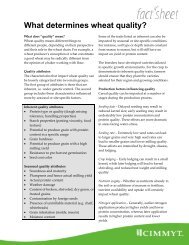


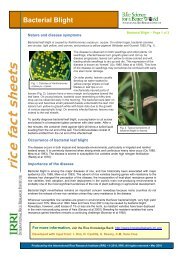

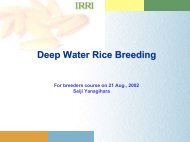
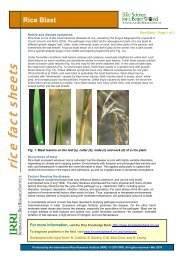
![International Standards' Organization â Rice Specification [ISO 7301]](https://img.yumpu.com/36696862/1/190x245/international-standards-organization-a-rice-specification-iso-7301.jpg?quality=85)

